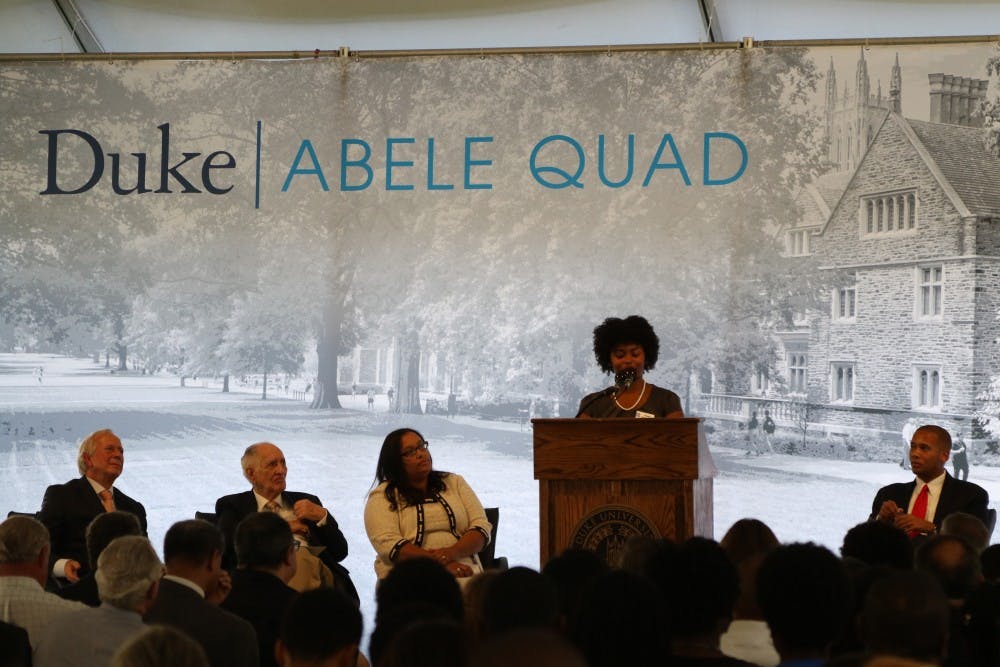The University dedicated what was formerly the Main Quadrangle to architect Julian Abele at a ceremony Friday.
Last year, the University—following the advice of an advisory group—named the Main Quadrangle "Abele Quadrangle" after black architect Julian Abele, who designed most of the buildings on West Campus. President Richard Brodhead and David Rubenstein, Trinity '70 and chair of the Board of Trustees, introduced Abele's legacy.
“Earlier I talked to the dean of the Divinity School [Elaine Heath], and I asked her to pray for some good weather. She did,” said Rubenstein, referring to rain right before the ceremony. “I recognized later that the rain was the tears of joy from Julian Abele coming down around us.”
The dedication ceremony included speeches from Julian Abele, Jr., university officials and leaders of black student and alumni groups. A plaque was revealed near the West Campus bus stop to identify the area as Abele Quad, informing visitors that "if you seek his [Abele's] monument, look around."
Administrators said they hope that the marker's central location will make Abele’s role in the design of iconic parts of campus hard to miss. This is especially important, Brodhead said, given the South's racial history.
“This University was built in the depths of segregation in the very segregated part of the United States," Brodhead said. "In the very middle of that America, a system of segregation, this magnificent and beautiful campus was thrown up as the work of a black architect—Julian Abele. To me, what this means is the beauty of this campus disproves everything that was then held up as true in this region of this country.”
Providing the long-absent attribution is not the only purpose of the plaque, said Danielle Squires, president of Duke Black Alumni.
"Today’s plaque, this dedication and the proud ownership of black excellence will propel our students further with a sense of great ownership in Duke’s story," she said.
Squires noted that during her time at Duke—from 1998 to 2002—she was not made aware of Abele’s role in designing West Campus, but that the Chapel has always had special meaning to her. Senior Tiana Horn, president of the Black Student Alliance, also noted the symbolism of Abele having designed the Chapel.
“The feats he accomplished would be phenomenal for any individual, but once you know the story behind it, you are able to get an idea of the struggle he was facing. His work becomes even more remarkable,” she said. “For me, when I walk past the Chapel I see something that is bigger than myself. Knowing Julian Abele’s life story makes me believe that I, too, can create something as phenomenal as the buildings we see around us.”
Abele, Jr. echoed his love of the Chapel, saying hat he considered his father’s designs for the University to be “his finest work”. Four generations of the Abele family attended the event.
“The whole family is very, very proud of this and we give the University full credit,” Abele, Jr. said.
Abele worked for the Philadelphia architecture firm of Horace Trumbauer beginning in 1906 and designed many well-known buildings, including the Museum of Art in Philadelphia and Harvard’s Widener Memorial Library. From 1924 to 1935, the firm oversaw the construction of West Campus, with Abele as the chief designer.
Brodhead noted that a biography of the architect has been commissioned and is being written by the University Archivist. There will also be a "tablet" installed inside the Chapel with a full explanation of Abele’s history and work.
“I hope everybody here recognizes that we have a long way to go in racial harmony, but this is Duke’s effort to make progress forward,” Rubenstein said in his speech. “Many other steps have to come, but this is an important step.”
Ocoszio Jackson, president of the Black Graduate and Professional Student Association, encouraged those present at the dedication to be part of those next steps by building on the work of their ancestors. He noted that the deadline to register to vote in North Carolina is quickly approaching, and that the right to vote was not easily won.
Junior Alan Davis, director of finance for Black Student Alliance, commented that the day was an important step in providing appropriate recognition for Abele’s contributions to the school.
“I’m very happy that they were able to represent Julian Abele in the correct way,” Davis said. “I feel like the work he has done on campus had really gone unrecognized until today.”
Get The Chronicle straight to your inbox
Signup for our weekly newsletter. Cancel at any time.
Bre is a senior political science major from South Carolina, and she is the current video editor, special projects editor and recruitment chair for The Chronicle. She is also an associate photography editor and an investigations editor. Previously, she was the editor-in-chief and local and national news department head.
Twitter: @brebradham
Email: breanna.bradham@duke.edu

